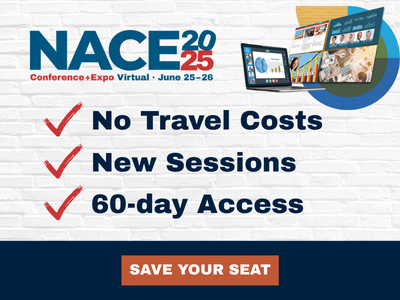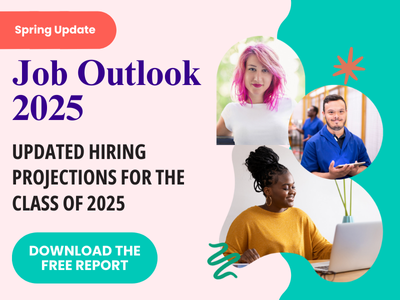The following is a chapter excerpted from Case Studies in Career Services, scheduled to be published by NACE in 2020.
Introduction
Online education, as we think of it today, emerged more than 20 years ago as the growing internet gave rise to a new way to deliver learning: distance learning. As the tools for distance learning have become more prevalent and, more importantly, interactive, access to education has expanded. This, coupled with growing career mobility and demands on employees to continue their education, drives online learning and has contributed to the rise of nontraditional students. New technology + new types of students = new demands on schools and their career centers.
Online education offers the same explicit and implicit promises as more traditional forms of education, one of which includes better employment options. However, one thing missing from the early stages of online education was student support services. While traditional brick-and-mortar campuses had long offered a robust array of support services for students—academic advising, counseling and health services, career services, and so forth—these elements were non-existent for online students. In some cases, the option to drive to a physical campus may have existed to get those support services. In most situations, online learners were locked into a very simple, transactional relationship with their online school—tuition for course access. Arguably, this is still largely the case at most institutions.
Background
In 2002, the online campus of Baker College numbered more than 4,000 students. Those students were scattered across all 50 states and around the world. In the face of its parent institution’s commitment to providing quality career education, Baker College Online and the Center for Graduate Studies launched a project that—over the next few years—was met with curiosity and a share of incredulity within our professional associations. That project was the first full-service career services office in the United States that operated entirely online.
In 2002, social media was in its infancy and the internet offered only limited tools for engaging others, plus the field of career services was still largely shaped by a traditional counseling disposition. Face-to-face services were the norm for engaging students. As the new center launched, the reasonable question posed was, “How does one provide career services to students one cannot meet with face to face?” The answer was remarkably simple: Adopt the same approaches that successful online educators used—establish your pedagogical goals, and then find the right methods for the audience. In other words, the online career center that Baker launched operated very much like its traditional campus centers. Career professionals knew the content that students needed to successfully launch and manage their careers, took that content, and modified it to best fit within the particular campus context to provide that education.
Over the course of the first five years Baker’s online career services office (OCS) faced numerous challenges: identifying and learning new technologies, tailoring career development content to its students and the available technologies, establishing credibility among students and colleagues, and expanding offerings to match peer on-ground campuses. Initially, the OCS was offered space on the main college website. However, Baker Online offered classes through Blackboard, not accessed via the college website. Since that was “campus” to Baker Online students, the OCS office lobbied for a permanent space on Blackboard. After some deliberation, the request was granted, and soon after, the OCS office was established with resource libraries, discussion boards divided by topic, office contact information for appointment scheduling, and so forth. OCS also inherited two online courses. The first, a multifaceted research project guided by a member of the OCS staff, was offered as a replacement to the internship/co-op requirement. The second covered career management and job-search skills. Over time, both course syllabi were refined to match current job market realities.
The first course proved problematic in its design, which stemmed from the assumption that experiential education could not be accomplished from a distance. To better support its students, the OCS implemented an experiential education requirement similar to, but more robust than, its sister campuses. Students had the option to do the research project or complete an internship. If taking the internship, students received support in identifying experiential education opportunities and, during the duration of the internship, were enrolled in an online course facilitated by OCS staff. The pilot group of students were very resistant to the internship until a week into the first run. Thereafter, even the strongest resistors had become staunch advocates, expressing appreciation OCS had implemented a valuable component to their education. Even the students’ employers, many of whom also served as internship site supervisors to other students, were impressed with the program. One employer emailed the OCS to express gratitude for helping the organization discover a “diamond in the rough.”
As the number and size of online campuses have grown, so have the demands to provide increased students services, including career services and post-graduate employment support. What was once a fringe curiosity has become a growing point of serious interest and consideration. The rise of institutions like Western Governors University, Southern New Hampshire University, and online expansion of University of Maryland’s University College demonstrate the viability of online education. Other schools such as the University of Pennsylvania are launching, relaunching, or expanding their online offerings. As the pursuit of lifelong learning translates into concrete needs for flexible learning options, the demand for online educational venues will continue to grow. So too will the service expectations of students.
Challenges
With the increase in enrollment numbers, particularly in the area of online and continuing education, coupled with the competitiveness of the higher education landscape, institutions are using support services and other amenities to attract students. As such, traditional career centers are being tasked with expanding support to include online students. Career development and transition support should be made available to all students, regardless; however, the challenge with this expansion offering is three-fold:
1. The traditional “silo-ing” of career centers on brick-and-mortar campuses poses a particular problem when connecting with stakeholders. Offices that are perceived as—and perceive themselves as—an on-ground resource whose primary coaching delivery mode is personal (face-to-face) connections may not have as robust of a network with the faculty and other service units working directly with online students and the technology that supports their learning. These units may even be structurally or geographically separated from the main activities and governance of the parent institution.
2. Scarce institutional resources translate to restricted access of critical training and support for online operations. Even high-level directives for a career center to engage online students do not necessarily guarantee access or support equivalent to what is needed to execute quality online career support.
3. Larger institutions may have online operations scattered across different academic units. An institution’s scattered approach can mean two, even three online learning platforms, plus college-by-college policies and standards can present a fragmented landscape.
It should be clear by now that simply having a website or interacting with students on Facebook or Instagram does not constitute operating as an online career center. An online career center functions with a clear, articulated vision to deliver a full suite of career development content tailored to the needs and delivery expectations of the institution’s students. But what exactly does a “full suite of online offerings” entail? Let’s find out.
Methodology
Launching or upgrading an online career center may pose little challenge to offices already adept at strategic planning and execution. However, successful engagement of online learners requires much greater effort, in part due to a retooling of how career professionals frame questions and answers around what we do and how we do it.
Since every office, parent institution, and online student population is distinct, no single template can support every online career center. Instead, it is recommended that the following questions be adopted as companions in the planning, deployment, and assessment or re-planning stages of an online career center.
Questions to Consider
1. How frequently do we assess our students’ perceived needs from our office, specifically their preferred modes of communication?
Why: Our audiences can change quickly. At minimum, annual assessment allows gauging of student expectations to calibrate messaging and offerings. One new app or online tool, rapidly adopted by your population, can make years of work and infrastructure obsolete. Your students and their digital habits will change, so keeping up and remaining relevant is important. Insisting students communicate according to the technology choices the career center made last year will only mean fewer students seeking out your office support.
2. Are our online courses synchronous, asynchronous, hybrid?
Why: Synchronous courses offer real-time delivery where everyone can participate at the same time. Asynchronous courses offer the opportunity for students and faculty to interact on their own schedules within the learning platform. Hybrid can be a combination of synchronous and asynchronous modes, or a combination of online and on-ground delivery. Online courses that require a weekend on campus or perhaps an on-ground course that has exams or other essential content exclusively online are two examples of the latter type of hybridization. The type of course design you offer impacts students’ expectations of not only interaction with a “live” person, but the frequency and mode of interaction.
3. What are the equivalents to the physical campus experience for our online students? Do you offer a digital commons, quad, or student union?
Why: All communities of learning have common spaces. On a traditional campus, these are spaces like classrooms, quads, student centers, and dining halls. Online campuses often have the same, either hosted online by the school or other spaces like wikis or Facebook pages. Just like on your physical campus, in the virtual space, know where your students interact with faculty and other student service professionals, and be there. High-traffic, high-visibility locations matter—even in virtual spaces. Do not expect students to leave the equivalent of campus to come find you.
4. What other services are provided by our institution to online students? Are any student affairs or student services fully handling remote engagement through digital channels?
Why: Students who receive the message, explicitly or implicitly, that they are only valued for their tuition dollars will view interactions with the school as cursory and transactional. Offering minimal support services or services that are inconvenient or out of date will impact the relationship the student has with your office and with the institution. Students become alumni. Alumni become donors. It is important to consider times and modes an office is available to serve students and, in the absence of “live services,” to ensure there is access to well-prepared self-service content for students to engage with independently.
5. Do we have professional staff equipped for online career coaching? Do we have professional staff who are digitally conversant and curious?
Why: While student workers or interns can be excellent stopgaps or additions to office support, social media marketing, and digital delivery outreach, the responsibility to career coach online students should rest primarily with trained, professional staff. Online career coaching is a competency-based, professional practice-level operation and must be treated as such. Cultivating institutional knowledge and history around this area ensures better strategic integration and maintenance of consistency across time.
6. Can we access the services of our online course/campus instructional designers? If so, are they driving quality into our online educational offerings, or are we better off creating and maintaining content ourselves?
Why: Whenever possible, leverage expertise readily available, and partner with these experts to ensure the product delivery is what you envisioned and ultimately adds quality to your campus. Specialists in online pedagogy and course design should drive innovation on the online platforms, so it is likely you’ll learn a lot in working side-by-side with these experts. Instructional designers often offer trainings the entire staff could take advantage of, especially if the career center is or will be charged with maintaining and updating content once the online platform has been built and launched. Investigate what kinds of training and professional development opportunities are offered/required by your institution and seek access.
7. Can career and professional development content be embedded in the curriculum either as stand-alone online courses or as segments/units within other online courses? If so, what is the best role for your office to serve in that space?
Why: As with on-ground populations, earlier engagement within the broader curricular context benefits students and shifts the burden from them seeking out career development too late or not at all. Depending on the ratio of office size to online student population, different approaches may be the best solutions for successful engagement. Operating as course developers (with guidance from your institution’s online course designers) and faculty for career courses gives the most control but is the most labor intensive. The other end of the spectrum has career development professionals serving as internal consultants to course development or coming into online courses for guest appearances. Offices with sufficient personnel can embed primary development and delivery of online content in the career center’s operations while drawing training and support from their institution’s online course designers. Another configuration for offices with limited capacity would have career center personnel work as consultants in the development process, with delivery left to existing online faculty.
8. What assessments and reporting do we have in place specific to the online population and online services?
Why: Not only is the actual academic year likely to be structured differently than that of your brick-and-mortar campus (academic calendar, course length, and so forth), so too will the populations themselves. Based on ranked online programs reporting data to USNews, the average age of an online bachelor’s student is 32, and approximately 84 percent of those students work while pursuing their degree. Assessment and reporting considerations then are two-fold:
- Logistically speaking, assessment, data collection, and reporting timetables may need to be different to support strategic planning and tactical delivery within the department. Shorter assessment and reporting cycles can be supported by the same technology used for service delivery and can drive a more nimble and responsive office.
- Population: The differences between online learners and traditional on-campus students means there may be divergences in their priorities and concerns. Assessment tools should be built to match and measure the target population, not operate on assumptions that all learners want or seek the same things. Using institutional data to build accurate profiles reflecting online students will guide initial attempts to shape suitable assessments and surveys.
Whether an office is expanding to include an online population or being built specifically to serve an online population does not matter. The planning and execution of a full-service career center remain the same.
Conclusion
Fundamentally, online career centers do not differ from their on-ground counterparts in any significant philosophical way. What we offer is what career development professionals have always offered: expertise in self-exploration and support with career decision-making and the post-graduate transition. What the online context changes is our audience and means of sharing our expertise. The technology involved may give a sense of the exotic, but by now we should be gaining some comfort, if not facility, with leveraging a wide range of computer-based tools to help us do our work.
References
Friedman, J. (2017, April 4). U.S. News Data: The Average Online Bachelor’s Student. USNews. Retrieved from https://www.usnews.com/higher-education/online-education/articles/2017-04-04/us-news-data-the-average-online-bachelors-student
Kentnor, H. E. (2015). Distance Education and the Evolution of Online Learning in the United States. Curriculum and Teaching Dialogue, 17 (1 & 2), 21-34.
McKenzie, L. (2018, April 23). The 100K Club. Inside Higher Education. Retrieved from www.insidehighered.com/news/2018/04/23/nonprofits-poised-unseat-u-phoenix-largest-online-university
National Association of Colleges and Employers. Career Readiness Defined (n.d.). Retrieved from www.naceweb.org/career-readiness/competencies/career-readiness-defined/
Peterson’s Blog: The history of online education (2017, November 29). Retrieved from www.petersons.com/blog/the-history-of-online-education/
Straumsheim, C. (2017, May 2). ‘Volatile’ but Growing Online Ed Market. Inside Higher Ed. Retrieved from www.insidehighered.com/news/2017/05/02/report-finds-growth-volatility-online-education-market
Bill & Melinda Gates Foundation (2018, October 29). Postsecondary Success: America 100 College Students. Retrieved from postsecondary.gatesfoundation.org/areas-of-focus/our-policy-advocacy/advocacy-priorities/america-100-college-students/america100collegestudents/







